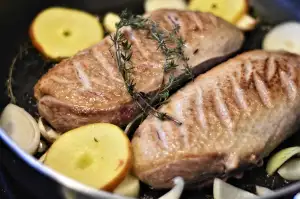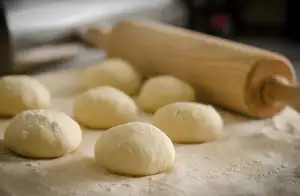Unlock the Secrets: Discover When a Pineapple is Ripe with Our Expert Tips

- Visual cues: Examining the color and appearance of the pineapple
- Smell test: Detecting the sweet aroma of a ripe pineapple
- Texture check: Feeling for firmness and slight give in the fruit
- Leaf tug: Assessing the ease of pulling out the pineapple's leaves
- Taste test: Sampling a small piece to confirm the pineapple's ripeness
When it comes to enjoying a delicious pineapple, timing is everything. The key to savoring its sweet and tangy flavor lies in knowing when the fruit is perfectly ripe. But how can you tell? In this article, we will unlock the secrets of determining a pineapple's ripeness, guiding you on your flavorful food adventure. From visual cues to smell tests and taste checks, we will equip you with expert tips to ensure that every bite of pineapple is bursting with tropical goodness. So get ready to discover the art of selecting a perfectly ripe pineapple and embark on a culinary journey like no other!
Visual cues: Examining the color and appearance of the pineapple
Visual cues play a crucial role in determining the ripeness of a pineapple. When examining the color and appearance of the fruit, look for a vibrant golden-yellow hue. Avoid pineapples with green or brown patches as they indicate under-ripeness or over-ripeness respectively. The skin should also be firm and free from any soft spots or bruises. A ripe pineapple will have a plump and symmetrical shape, indicating that it has reached its peak flavor. Remember, a visually appealing pineapple is often a sign of its deliciousness within!
Smell test: Detecting the sweet aroma of a ripe pineapple
One of the best ways to determine if a pineapple is ripe is by using your sense of smell. A ripe pineapple will emit a sweet, tropical aroma that is hard to miss. Take a moment to inhale deeply near the base of the fruit. If you are greeted with a strong, fragrant scent, it's a good indication that the pineapple is ripe and ready to be enjoyed. On the other hand, if there is no noticeable aroma or if it smells slightly fermented or sour, it may not be fully ripe yet. Remember, a sweet and enticing fragrance is key when it comes to selecting a perfectly ripe pineapple for your culinary adventures.
Texture check: Feeling for firmness and slight give in the fruit
When it comes to determining the ripeness of a pineapple, texture plays a crucial role. To check for ripeness, gently press your fingers against the fruit's skin. A ripe pineapple should feel firm but also have a slight give when pressed. If the fruit feels too hard, it may not be fully ripe yet. On the other hand, if it feels too soft or mushy, it may be overripe and starting to spoil. Finding that perfect balance of firmness and slight give will ensure you enjoy a pineapple at its peak of flavor.
Leaf tug: Assessing the ease of pulling out the pineapple's leaves
Another way to determine if a pineapple is ripe is by giving its leaves a gentle tug. Hold the pineapple firmly in one hand and grasp the top set of leaves with your other hand. Gently pull upwards, applying slight pressure. If the leaves come out easily, without much resistance, it is a good indication that the pineapple is ripe.
However, if you encounter difficulty in removing the leaves or they snap off instead of coming out smoothly, it means that the pineapple is not yet fully ripe. In this case, it's best to wait a little longer before enjoying its sweet juiciness.
Remember that while this method can be helpful in assessing ripeness, it should be used in conjunction with other indicators such as color, smell, and texture. By combining these different techniques, you can ensure that you select only the most delicious and perfectly ripe pineapples for your culinary adventures.
Taste test: Sampling a small piece to confirm the pineapple's ripeness
While visual cues, smell, and texture can provide valuable information about a pineapple's ripeness, the ultimate confirmation lies in its taste. Once you have examined the color, appearance, and firmness of the fruit, it's time to take a small bite.
Choose a section near the base of the pineapple and carefully cut off a small piece. Place it on your tongue and let the flavors unfold. A ripe pineapple will explode with sweetness and juiciness, leaving a delightful tangy aftertaste.
If the pineapple tastes slightly sour or lacks that burst of sweetness, it may not be fully ripe yet. However, if it tastes overly sweet or fermented, it might be overripe. The perfect balance is what you're looking for – a harmonious blend of sweet and tangy notes that will make your taste buds dance with joy.
Remember to savor this moment as you indulge in nature's tropical delight. The taste test is the final step in unlocking the secrets of a perfectly ripe pineapple – one that promises an unforgettable culinary experience.
In conclusion, discovering when a pineapple is ripe is an essential skill for any fruit lover. By examining its color, aroma, texture, and ease of pulling out the leaves, you can determine if it's ready to be enjoyed. And of course, the ultimate confirmation comes from tasting a small piece. When you find that perfect pineapple at its peak of flavor, savor every juicy bite and let your taste buds embark on a delightful adventure.
Published: 26. 11. 2023
Category: Recipes



